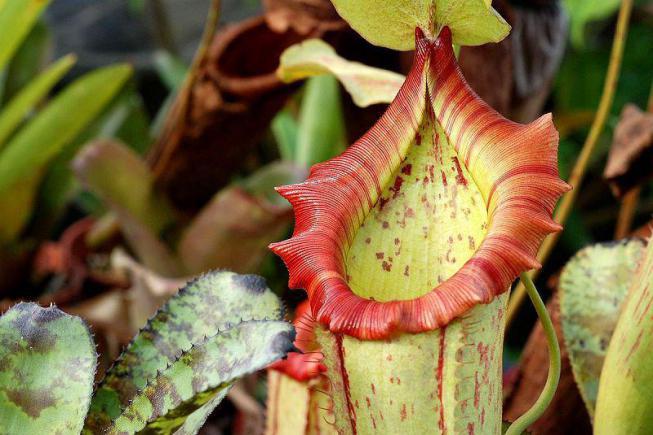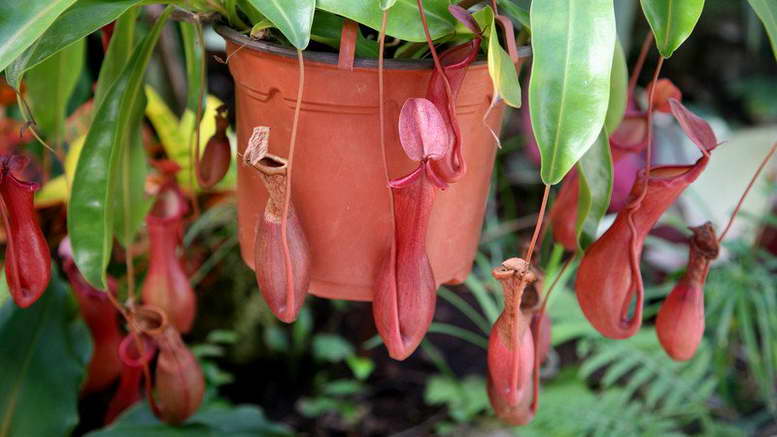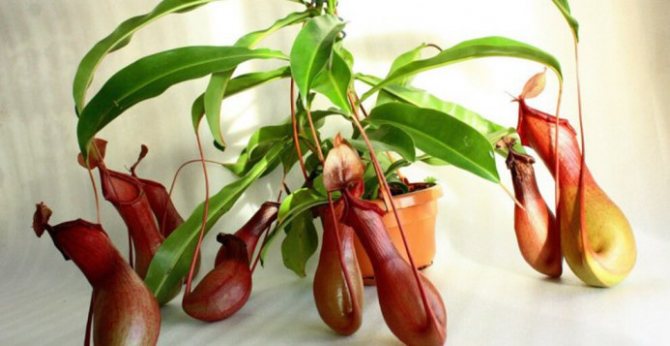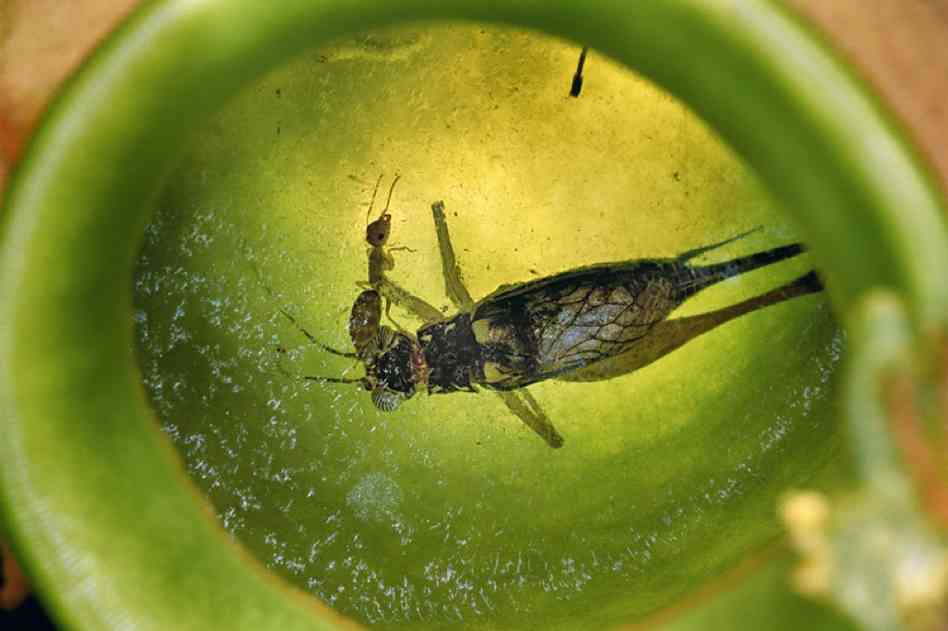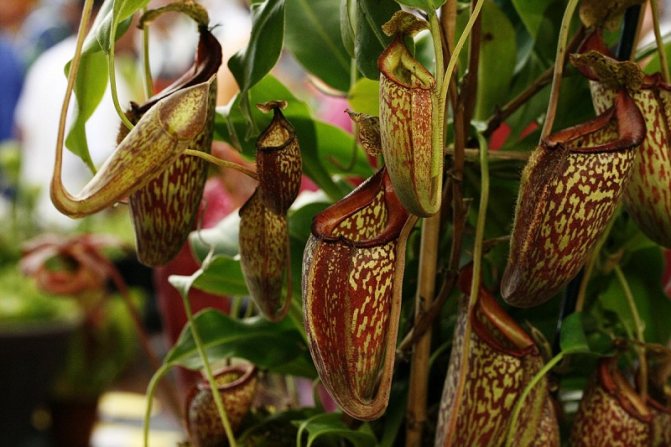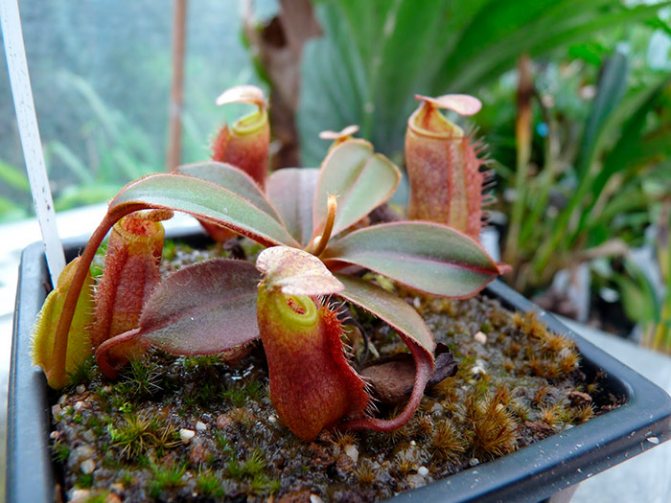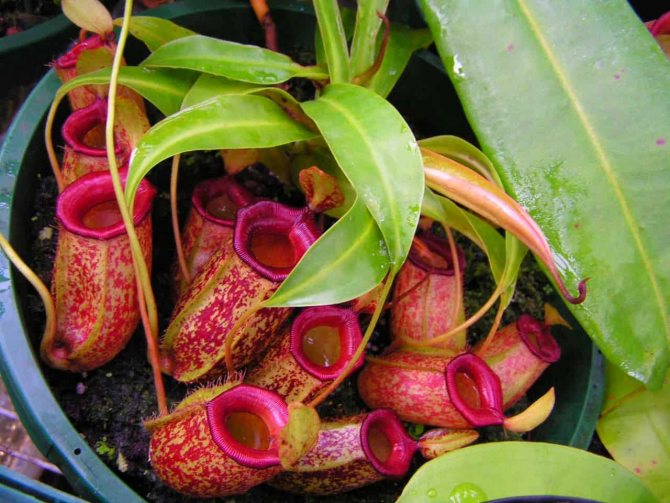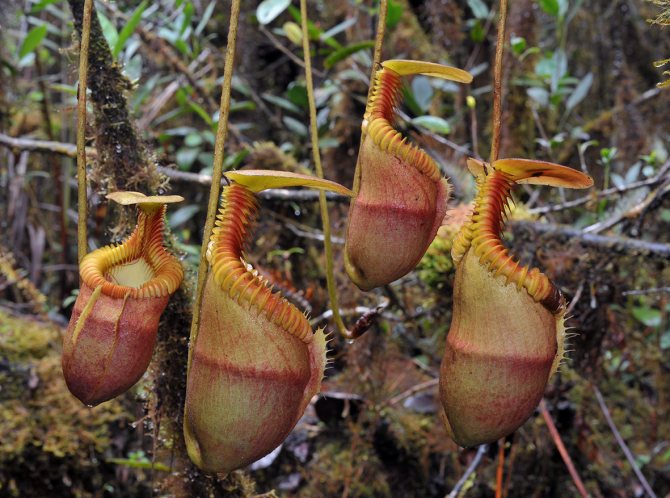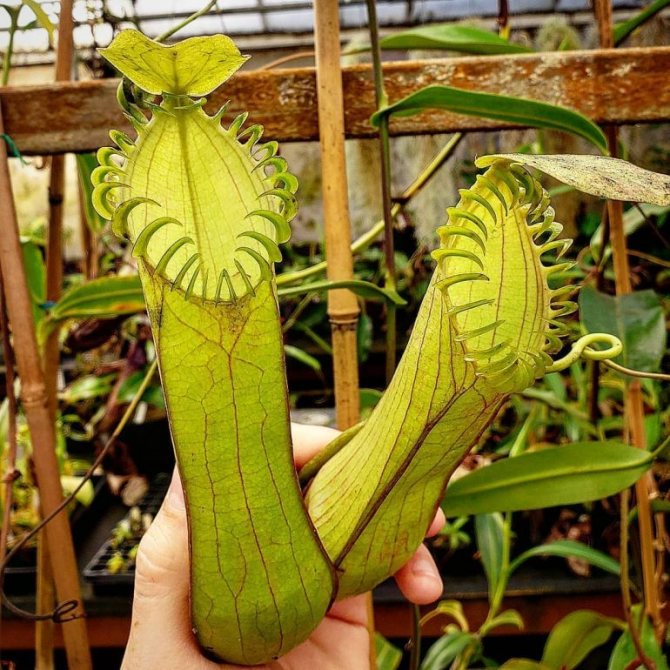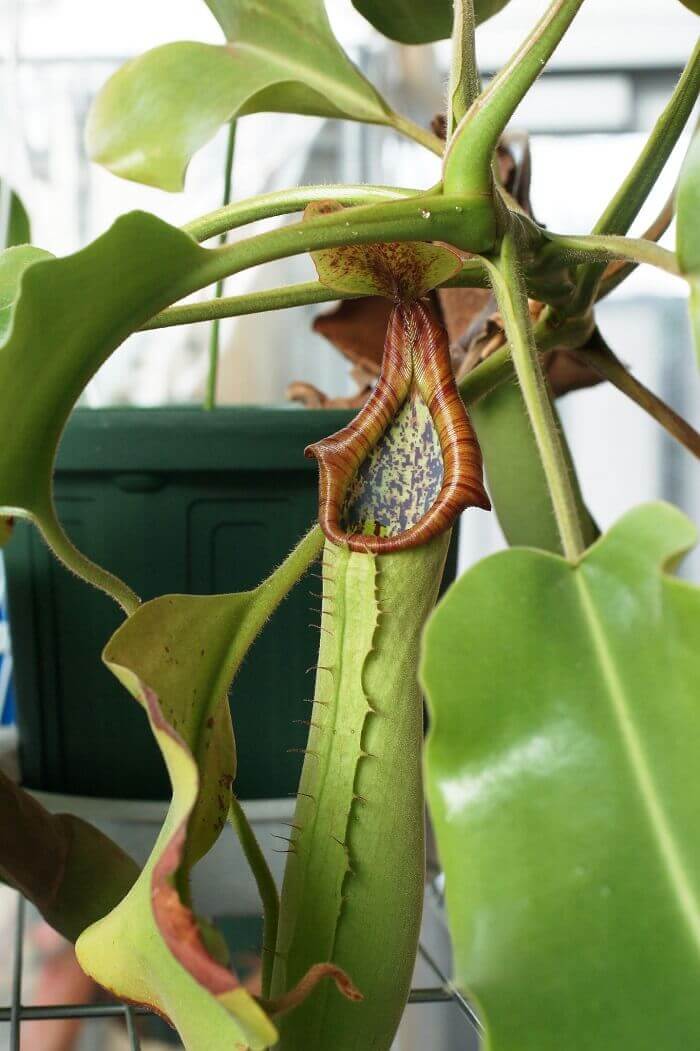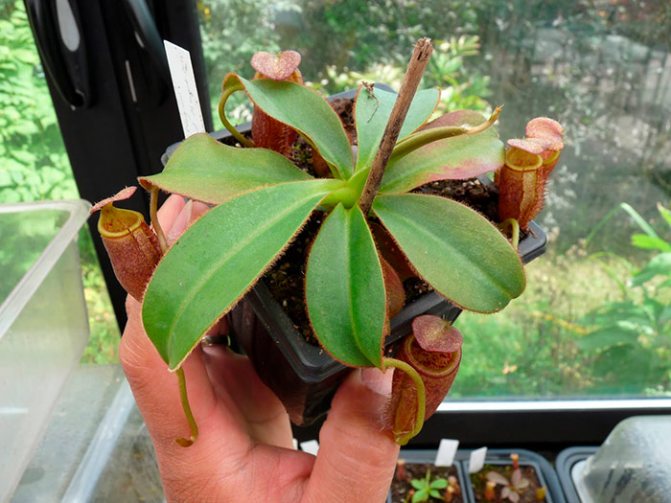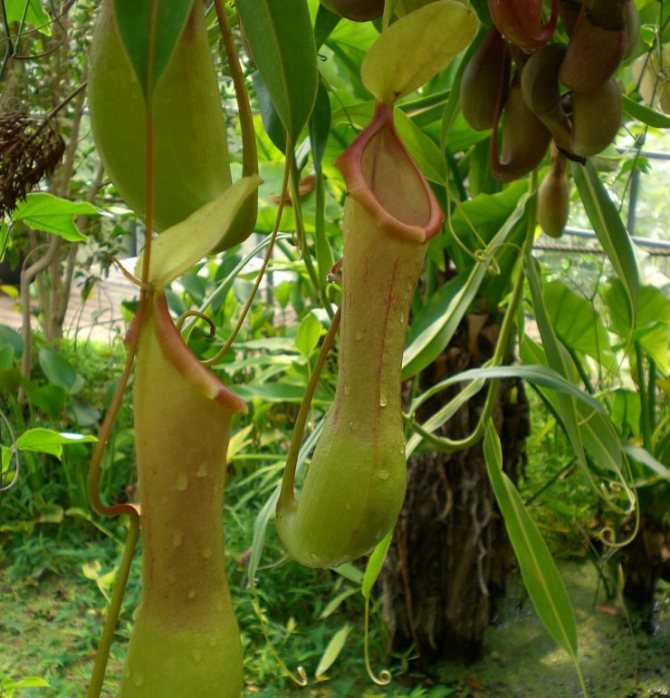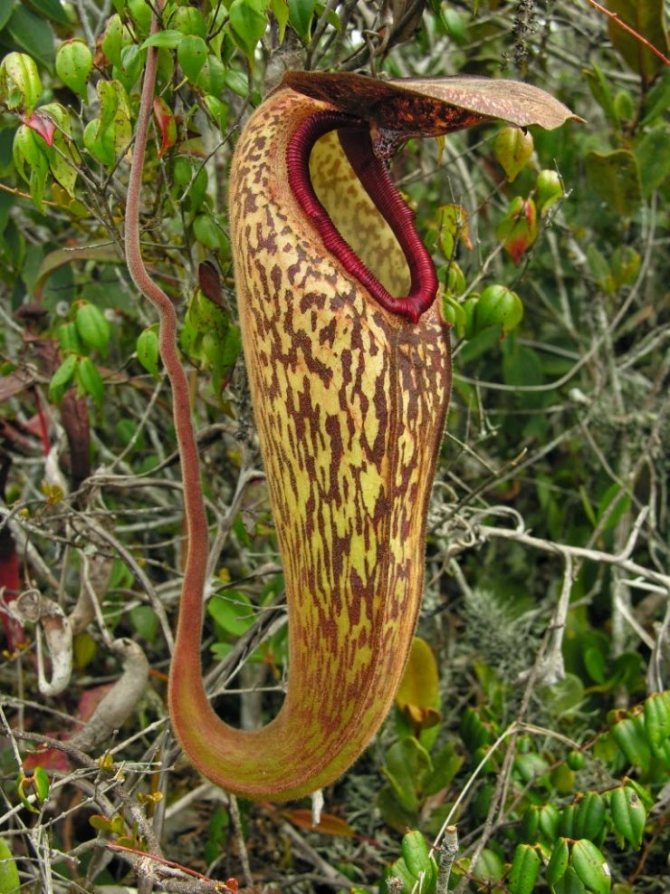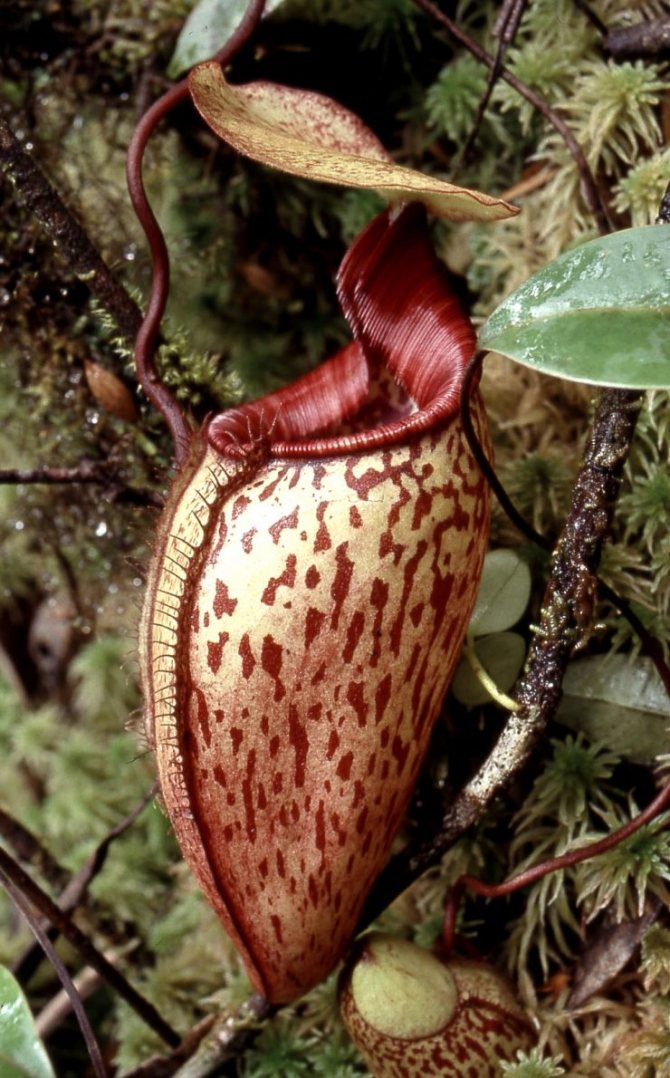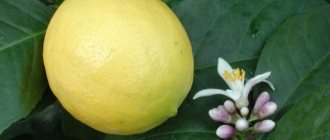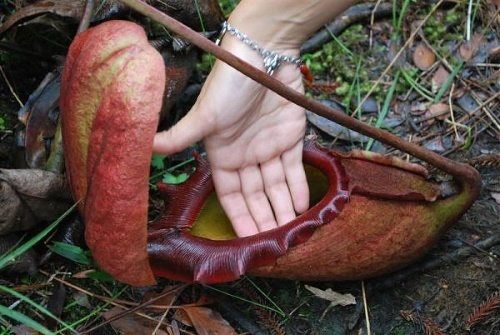
The fashion for collecting outlandish things has always been and will always be. Some collect commemorative coins or stamps, while others prefer exotic plants. We are not talking about tangerines or kiwis on the windowsills, but about real predators. They do not need fertilizers, and live insects serve as food for plant hunters. One of these predators is the sundew, which is often grown at home. But you are unlikely to find the largest carnivorous plant in greenhouses and houses. Nepentes Raja - this is the name of the carnivorous bush with the largest trap. What does it look like, where does it grow and what does it eat?
Planting and caring for a nepentes
- Bloom: from 3 to 7 months in spring and summer.
- Lighting: bright diffused light (southern or eastern window sills with shade at noon). When grown on a northern windowsill in winter, the plant will need additional artificial lighting for 16 hours.
- Temperature: mountain species feel good in the warm season at a temperature of 18-20 ˚C, and in winter - at 12-15 ˚C. Plains Nepentes prefer temperatures from 22 to 26 ˚C during active growth, and 16-20 ˚C in winter.
- Watering: regular, preferably through the drainage holes. In the warm season, the substrate in the pot should be slightly damp all the time, and in winter it should be allowed to dry to a depth of 5 mm.
- Air humidity: for some species, a very high humidity is required - 70-90%, for others, a humidity level within 40% during the day and at least 50% at night is sufficient. Keep the nepentes on a pallet of wet peat or expanded clay and spray the leaves with water daily.
- Top dressing: nepentes is an insectivorous plant and does not need fertilizers. Place a live bloodworm, fly, or spider in one pitcher once a month, and on a different basis each time.
- Rest period: it is not pronounced, but because of the working heating devices, the jugs begin to dry out. In the spring, simply cut the leaves almost to the base, restore the watering regime and water the substrate with a very weak solution of complex mineral fertilizer.
- Transfer: in the spring, in case of emergency.
- Reproduction: by cuttings, dividing the bush and by seed method.
- Pests: aphids and mealybugs.
- Diseases: fungal rot.
Read more about growing nepentes below.
When nepentes blooms
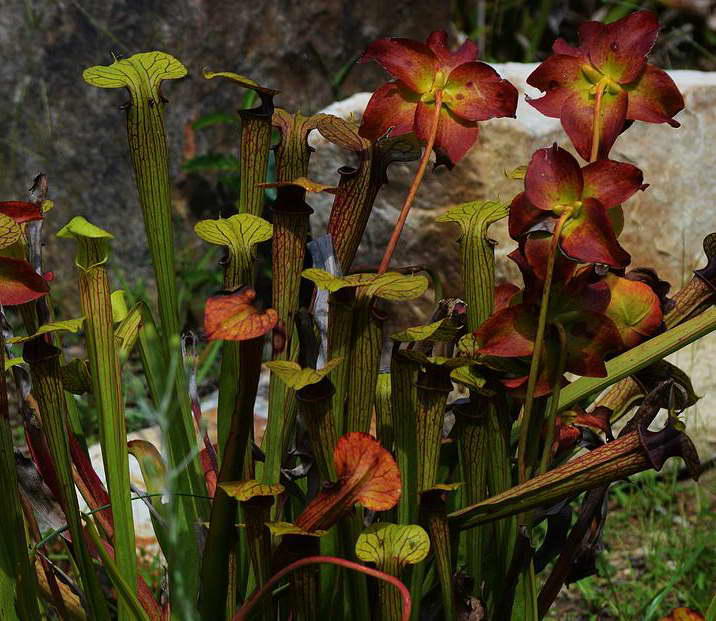

How nepentes blooms photo
Nepentes is in bloom for about 6 months. The racemose inflorescence consists of small, petalless flowers with sepals. Let the inflorescences do not have special beauty, but they give the bush an unusual appearance.
Nepentes are dioecious plants (female and male flowers are found on different plants, and it is almost impossible to distinguish them by their appearance).
Sometimes Nepentes are called hunting cups: there is clear water in the jug on top (a couple or more sips). At the bottom, of course, the remains of insects float, but acting carefully, you cannot reach them.
Culturally, nepentes is best grown in a greenhouse. Small nepentes can be planted in a glass aquarium, large ones look spectacular in a hanging pot (just place them away from heating systems, there should always be a vessel with water below to maintain the humidity level).
Other plant names: monkey pitcher, pitcher pitcher.Seed and vegetative (cuttings, layering) reproduction of nepentes is possible.
Nepentes plant - description
The insectivorous plant nepentes is most often a semi-shrub or shrub mixotrophic liana. Nepenthes with long herbaceous stalks climb the branches and trunks of trees many meters in height in search of sunlight for their narrow terminal paniculate or racemose inflorescences. The leaves of the Nepenthes are large, alternate, with a convex median vein and a drawn apex.
Venus flytrap - home care
In addition to ordinary leaves, jug-like leaves develop on the plant, the lower part of the petiole of which, connecting with the stem, is flat and wide, and then it is transformed into a thin tendril wrapping around a branch, at the end of which a jug hangs like an outlandish flower. The size, shape and color of the jug depend on the type of nepentes. The length of the trap can be from 2.5 to 30 cm, although there are types with jugs of half a meter. The color of the jugs is usually bright - dull white, mottled, red or light green with crimson dots. The upper edge of the jug is bent inward and covered with purple or pink grooves.
- How to properly water phalaenopsis
Special cells located on the inner edge of the jug produce sweet nectar, the inside of the jug is filled with water or digestive fluid containing the enzyme nepentesine, and the neck is covered with a lid to prevent debris from entering the trap. Insects, attracted by the scent of nectar, crawl under the lid, slide into the digestive fluid and drown in it. Digestion of food lasts from 5 to 8 hours, as a result, only the chitinous membrane remains from the insects. Sometimes even birds, amphibians and rodents get into the jugs.
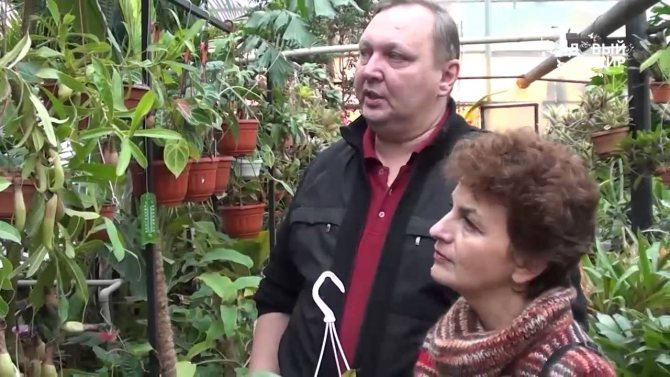

The flowers of the nepentes are inconspicuous, dioecious, petal, with tiled sepals. The fruit is a leathery capsule, divided by partitions into chambers, in each of which small seeds ripen.
In room culture, nepentes is still rare, since almost all representatives of the genus are too large for small greenhouses, and it is difficult to keep a predatory nepentes on the windowsill - it requires high humidity. It is best to grow nepentes in greenhouses, and their medium-sized species on a "closed tropical window".
Diseases, pests and other difficulties in care
With conscientious observance of the care recommendations, the plant is not exposed to diseases and pests. Let's consider the possible difficulties.
- When grown in clean peat or moss, chlorosis is possible. Substrate replacement will be required. Remove the affected leaves.
- Among the pests, aphids, mealybugs can disturb. This happens from dry air. If pests are found, treat with an insecticidal preparation.
- Slow growth rates, stretching of the plant, small leaf plates, a small number of jug-like leaves or they are completely absent - insufficient lighting combined with low
- The result of excessive watering can be root decay: the leaf plates will become wrinkled, drooped, the stems turn black. An emergency transplant will be required. Cut off the affected areas, treat with a fungicide.
- The leaf plates are covered with red, brownish spots - the defeat of a fungal disease as a result of waterlogging of the soil. Remove affected areas, treat with fungicide, adjust watering.
- With a lack of nutrition, the plant turns yellow. You need to feed.
- Spots with dead particles appear on the leaves - sunburn.
Caring for nepentes at home
How to care for a nepentes
Nepentes needs a bright, but diffused light, so it is best to keep the plant on the southern or eastern windowsill, protecting it from the midday burning rays with a translucent cloth or paper. When growing a pitcher on the west or north window, arrange for additional lighting for it. In winter, artificial lighting should work for 16 hours.
According to the requirements for temperature conditions, the types of nepentes can be divided into two groups:
- mountain - these plants grow comfortably in spring and summer at a temperature of 18-20 ºC, and in winter - at 12-15 ºC. Too high a temperature for a long time can provoke the development of diseases;
- Plains Nepentes prefer temperatures from 22 to 26 ºC in summer, but in winter it should be in the range of 16-20 ºC. At lower temperatures, plant life can be threatened.
Ventilate the room regularly so that the air does not stagnate in it, but protect the nepentes from drafts and try to move it as little as possible, because the plant does not like movement and turns around the axis. If you disturb him, nepentes can freeze for a month and a half and stop forming jugs.
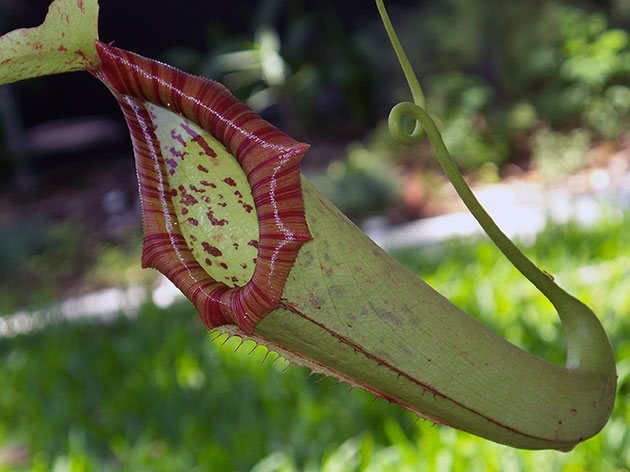

Since nepentes is a vine, you should prepare a support for him, to which he will need to be tied up as soon as he reaches a height of half a meter. It is best to establish a support when transplanting a one-year-old plant.
Watering nepentes
Caring for nepentes includes such a mandatory item as regular moisture of the substrate. For watering plants, they use distilled or at least filtered, settled or rainwater at room temperature, and preferably a couple of degrees warmer. The method of watering nepentes is the lower one, after which it is imperative to allow excess water to drain. In spring and summer, the substrate in the pot should be slightly damp all the time; in winter, nepentes are watered a couple of days after the top layer of the substrate is 5 mm thick. If the plant hibernates in a cool place, watering should be careful and not very abundant.
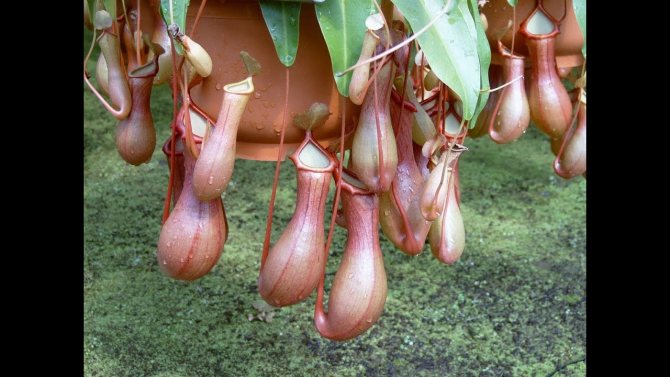

The moisture-loving predator nepentes needs not only moist soil - many species also need high air humidity in the range of 70-90%. However, among the pitchers grown in room culture, there are many for which a humidity level of 40% during the day and 50% at night is sufficient. Observe the condition of the plant in your usual conditions - it is quite possible that it will be able to adapt to the humidity of the air in your home, but if this does not happen, spray it daily with settled water and place the pot of nepentes on a tray with wet peat or expanded clay.
Nepentes transplant
Nepentes are transplanted only if necessary, which arises, for example, when mold appears on the substrate or the pot ceases to correspond to the size of the root system. Pots, hanging baskets for orchids or flower pots are used as dishes, and the diameter of the dishes should be at least 14 cm. The substrate can be store soil for orchids.
If you prefer to prepare the soil for nepentes yourself, mix three parts of leafy soil, two parts of peat, one part of sand and add some charcoal to this mixture. Or, add two parts high peat to two parts perlite and one part vermiculite. Keep in mind that the pitcher does not like acidic soils.
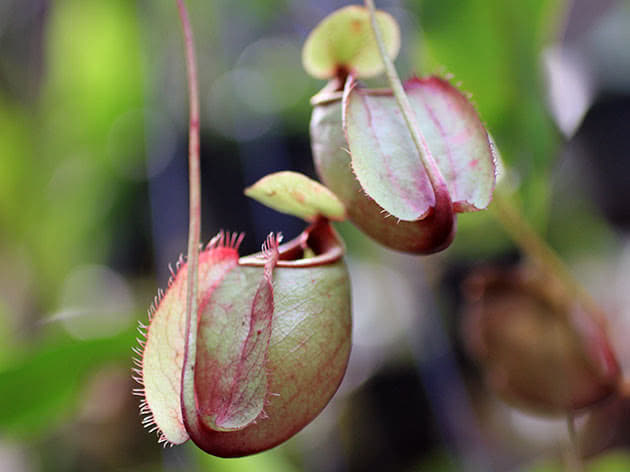

The transplant is carried out in the spring. If the plant is absolutely healthy, it is transferred from the old dish to the new one, being careful not to damage the roots. But if you are worried about the appearance of nepentes, remove the plant from the old pot, clean the root system of the substrate and rinse it with distillate, then finish the transplant in the usual way, water the substrate and spray the pitcher on the leaves with a solution of Fundazol or Topaz so that the composition gets into the substrate. ...
If the rooting of nepentes is successful, after a couple of weeks, spray the flower and spill its substrate with a solution of Zircon at the rate of 2-3 drops of the drug per 200 ml of distilled water.After a properly performed transplant, nepentes will live in a new pot for 3-5 years, and if you use volcanic stone, mineral wool, coconut shells or any other slowly decaying materials as a substrate, then the next time the plant will need to transplant only after 10 years.
- Houseplant groups (part 1)
Fertilizing nepentes
There is no need to fertilize the nepentes soil, since the carnivorous flower gets its food by eating insects. But there will be no harm if in the summer, once a month, you apply a complex flower fertilizer to the substrate in a consistency three times weaker than recommended for indoor plants: if you overfeed nepentes with fertilizers, it will not form jugs.
At home, Nepentes is fed once a month, throwing bloodworms, a spider or a fly into a jug - one insect per jug, and not all, but only half, otherwise the plant will die from excess nitrogen. The insect must be alive. The digestive secret is formed in the jugs only once, and if the jug is suddenly empty, it will no longer work like a stomach, so do not throw insects into it - this will only lead to the death of the leaf. To extend the life of an empty jug, fill it one third with distilled water.
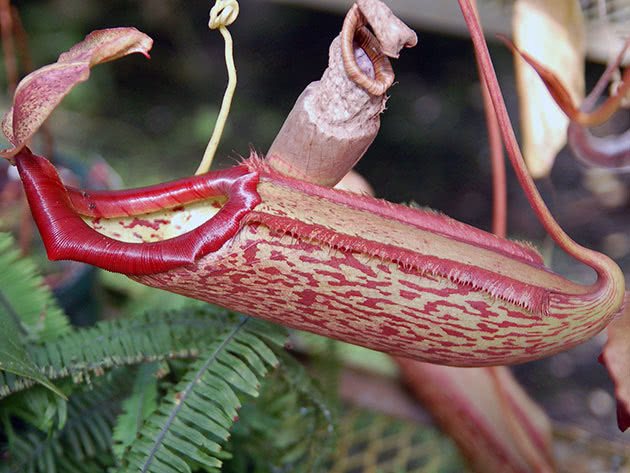

Growing features
- Priming. Nepentes should be provided with a pot filled with commercial potting mix (for orchids). Self-preparation of the soil is allowed. This will require the following ingredients: leaf land (3 shares), peat (2 shares), coarse sand (1 share). To the resulting composition, the addition of moss, charcoal is practiced. Another option for preparing a substrate for nepentes involves the use of high-moor peat (2 shares), perlite (2 shares), vermiculite (1 share).
- Watering. Nepentes likes moist soil, but too wet soil is contraindicated for him. Distilled water is used (rainwater, settled water can be used) at room temperature. The priority is the lower irrigation method (subject to the mandatory drainage of excess water). In hot weather, watering is done every 2 days. In the cold season, irrigation is performed weekly.
- Top dressing. In the summer, the soil in a pot with nepentes is fertilized with a complex composition that is weak in consistency. Overfeeding can cause the flower to refuse to form "jugs". Do not forget that the predator needs food in the form of insects. Flies or spiders should be thrown into his "jugs" every month.
Important! It is not recommended to feed all "jugs" at once, which can lead to the death of a flower due to oversaturation with nitrogen.
Flowering nepentes
Caring for nepentes during flowering
Nepentes flowers, regular, reddish-brown, collected in erect inflorescences, bloom for a long time, sometimes more than six months. You cannot call them spectacular, but nevertheless their unusualness attracts.
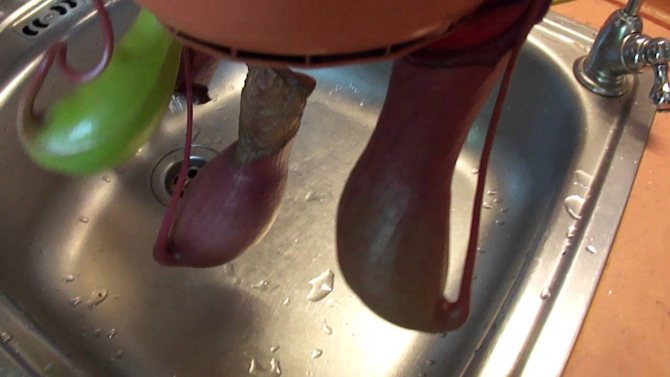

Nepentes in winter
Nepentes does not need rest, but due to the fact that our winters are not like tropical ones, the content of the plant has its own subtleties. With the onset of deep autumn, all kinds of plant feeding are stopped, and the intervals between watering become longer. Do not be nervous about the fact that the jugs begin to shrink - this is due to the fact that the air in the room is too dry in winter. In the spring, before the start of the new growing season, trim off all the leaves almost to the base, resume normal watering, add a fertilizer solution to the substrate, and the nepentes will grow again.
Care
Nepentes is a light-loving plant. In insufficient light, normal growth is disrupted. This plant requires abundant watering. It is always necessary to ensure that the soil substrate is moist.
The substrate for nepentes can consist of moss, bark and peat taken in equal parts. A drainage layer is placed on the bottom of the pot when planting.The transplant is done once a year, in the spring.
The optimum temperature for growing nepentes is 22-25 ° C. Nepentes may not need fertilizing.
To enhance branching, old specimens are heavily pruned in the spring. The cut stems can be used to propagate the plant.
Most hybrids are propagated by apical or stem cuttings, best of all in sphagnum moss, using root formation stimulants in a mini-greenhouse at a temperature of at least 25 degrees and high humidity. Roots are formed within 2.5 months.
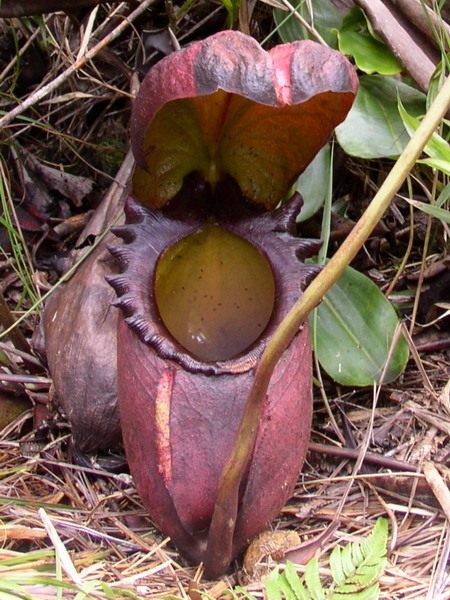

Nepentes Raja.
Reproduction of nepentes
Growing nepentes from seeds
Generative reproduction of nepentes is an interesting and not very difficult process, if you do not take into account the fact that you are unlikely to be able to buy seed material: no matter what the sellers promise you, instead of nepentes seeds you will most likely get the seeds of some other plant. Another problem of generative reproduction is that the seeds of the pitcher pot do not germinate longer than 2-3 weeks. But if you can get your hands on fresh seed, you will almost certainly be able to grow nepentes from seed.
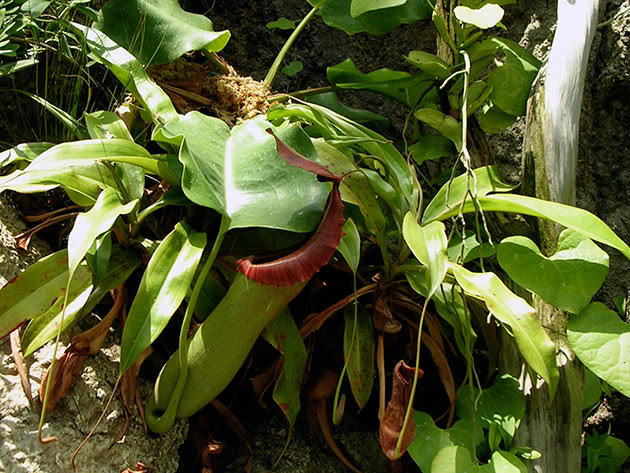

Seeds are evenly distributed over the surface of moistened sphagnum, thoroughly washed and disinfected for 2-3 minutes in the microwave, and then placed in a plastic container with drainage holes. Crops are moistened from a fine spray, immersed in a plastic box, covered with a transparent lid to create maximum air humidity around the crops, and placed in a greenhouse under a phytolamp.
You have to ventilate the crops every day and measure the humidity and air temperature in the greenhouse, which should be maintained at 20 ºC and 90-100%, respectively. As soon as the sprouts appear, care for them as you would any tropical plants, but try to extend their adaptation to the conditions of your home for several weeks.
Propagation of nepentes by cuttings
It is much easier to propagate nepentes by vegetative methods, for example, by cuttings, especially since in early spring after pruning the pitcher, you will have many cuttings for rooting. The ideal cutting is a cut with three leaves, which are shortened by 2/3. If the stalk is apical, the small top sheet can be omitted. Before planting, the cuttings are placed in Kornevin's solution for 30 minutes, after which the slices are sprinkled with crushed coal.
The container for planting cuttings must be well washed with bleach, and then be sure to rinse with distillate. The substrate for grafting is made up of coconut fiber, sphagnum and peat in a ratio of 3: 2: 5 with the addition of a small amount of vermiculite, after which the soil must be processed in the microwave for 15 minutes. Do not forget to moisten the substrate with distilled water before doing this.
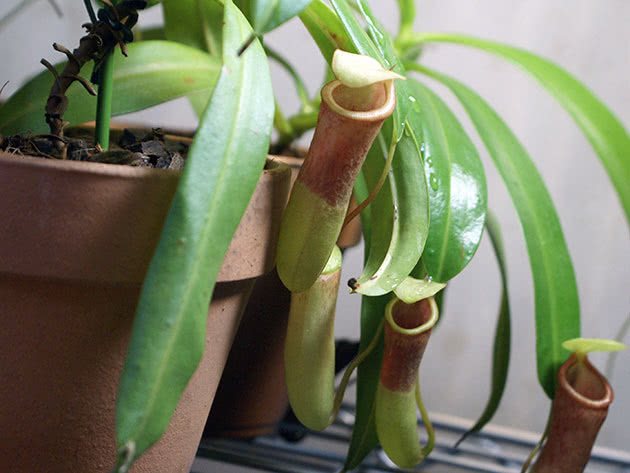

The lower cut of the cuttings is immersed in the soil by at least 5 mm, the substrate is carefully pressed around the cuttings, watered with distillate, and the cuttings are sprayed with a Fundazole solution, after which the container is placed in a greenhouse - under a large plastic bag or a transparent plastic cap. They keep the greenhouse in a bright place at a temperature of 23 ºC. After two weeks, you need to spray the cuttings and shed the substrate with a solution of Zircon - 2-3 drops of the drug are dissolved in 200 ml of distilled water.
Rooting usually lasts a month or a month and a half, but after two weeks it will become clear whether the cuttings have started: if they darkened, then rooting did not take place, but if the planted segments give new shoots with jugs, we can assume that the process was successful. And in a year it will be possible to transfer new plants into personal pots.
Reproduction of nepentes by dividing the bush
Nepentes multiplies by dividing the bush during transplantation, however, its roots are so fragile that they can be easily damaged. If you have experience in such matters, then take the risk of implementing this type of reproduction.The order of division of the nepentes bush is no different from the process of division of other plants.
The nuances of transplantation, reproduction
Experienced florists advise replanting nepentes as needed (if the rhizome has grown too much, the flowerpot has become cramped; when mold appears on the ground). The procedure must be carried out in the spring. Healthy nepentes is determined in large containers by the transshipment method. If the plant looks painful, you will need to clean the rhizome from the ground, followed by rinsing with a manganese solution. The substrate in a new flowerpot is watered with a fungicide. The next transplant can be performed after 3-5 years.
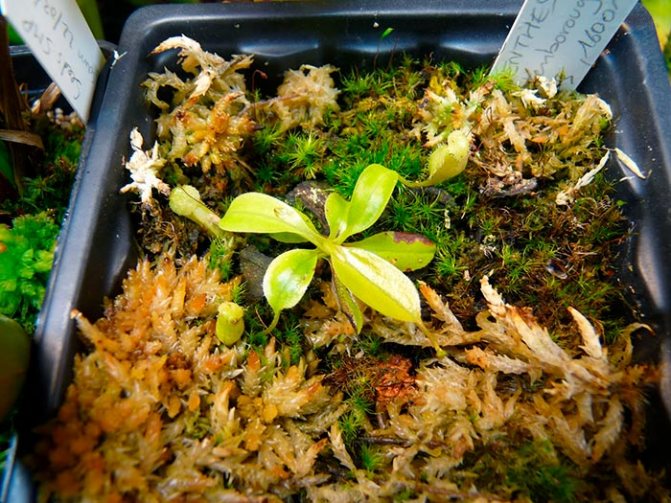

For breeding nepentes are used:
- seeds;
- cuttings;
- division of the bush.
Among flower growers, cuttings are considered the most popular. The method involves the use of segments with 3 sheets. The shoots are stuck into the substrate, watered, covered with polyethylene, placed in a bright place. Their rooting (subject to periodic spraying of the soil) will take about a month. Young plants are planted in new containers.
Bush division is practiced during the nepentes transplant. Rhizome segments are characterized by increased fragility and should be separated with great care.
Attention! It is not recommended to use seeds at home. This is the prerogative of experienced florists who specialize in improving the species' qualities of the plant.
Nepentes is a flower that can decorate any interior, become a spectacular highlight of the home. A florist who has mastered taming a predator will definitely be rewarded! He will be able to admire the magnificent plant for many years.
Would you like to grow a similar crop on your windowsill?
Diseases and pests of nepentes
Diseases of nepentes
Sometimes the leaves of nepentes are covered with brown or red spots, which is a sign of a fungal disease that develops against the background of increased moisture in the soil and air. To treat a plant from infection, treatment with fungicidal preparations is used. If the stem of the nepentes turns black, and the leaves wrinkle and wither, then you water it too often, and its roots rot.
Why do the leaves of nepentes rot? For the same reason - due to excess moisture. Try to save the flower by removing it from the substrate, carefully cutting off the rotten organs and areas with a sterile tool, treating the sections with crushed charcoal and transplanting the plant into a new sterile substrate. If it was not possible to save the nepentes, root as many cuttings as possible, and it is quite possible that after a while you will grow new nepentes.
- Katarantus: growing from seeds at home and in the garden
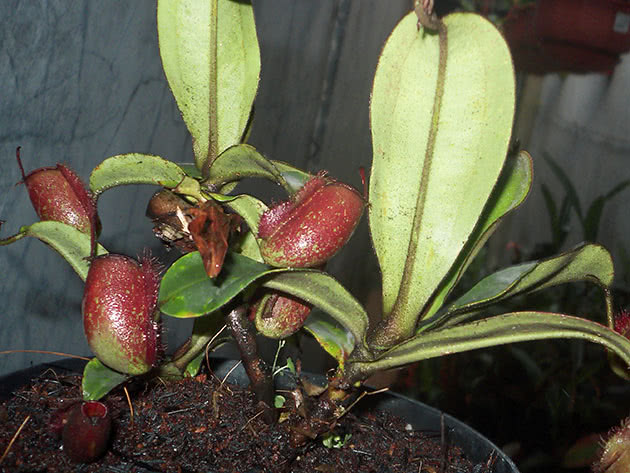

Leaves that turn yellow at the wrong time indicate that the plant lacks nutrition, and if the leaves turn red, then it is likely that this is a consequence of sunburn. Brown spots with necrotic areas on the leaves indicate that there is too much light for the nepentes, and the plant stretches painfully from insufficient lighting, but at the same time its development slows down, the leaves grow small, and the jugs are not formed.
Nepentes pests
Among insects, nepentes damage aphids and mealybugs. Worms suck juices from young shoots and leaves of the plant, which slows down their growth. To protect nepentes from the appearance of worms, remove dry leaves in a timely manner and keep the plant clean - wash and spray it, because the worms do not like moisture. If they do appear, remove them mechanically with a cotton swab or ear stick soaked in beer, alcohol or soapy water, then treat nepentes for six weeks with an imidacloprid-based preparation with an interval of 7-10 days between sessions.
Unfortunately, aphids are found on plants even when the harm caused by them becomes obvious - the colonies of the pest are located on the underside of the leaves, which are covered with honeydew and gradually turn yellow.In addition, aphids carry viral and bacterial diseases for which there is no cure.
The most harmless way for plants to get rid of aphids is to dilute 20 g of grated green potassium soap in one liter of water and wash the plant with this solution, remembering to protect the substrate from soapy water. Laundry soap or liquid dishwashing detergent can be used instead of green. Of the chemical preparations against aphids, Antitlin, Biotlin, Karate and Decis, which have low toxicity, are effective.


How to transplant nepentes video and description:
Transplant the plant as it grows (when the roots begin to protrude from the drainage holes). The frequency is 2-3 years. Proceed carefully to protect the taproot from damage, use the earthen ball transfer method. Nepentes grows best in a clay container.
The composition of the soil mixture can be different:
- Two parts of peat land, one part of sphagnum moss, 0.5 parts of sand
- Three parts coconut fiber and one part dried sphagnum moss
- Equal ratio of perlite and sphagnum moss
- In equal proportions, sphagnum moss, perlite, quartz sand;
- Equal ratio of peat, coconut fiber, shredded bark.
- In equal parts, a mixture of high-moor peat, chopped bark, coconut fiber.
- Substrate for orchids, epiphytic plants.
You can add some charcoal to any mixture. Pre-bake all ingredients in the oven.
Types and varieties of nepentes
In nature, there are 7 species of a pitcher, and the place in the classification of another 247 hybrid plants is still in question. Nepenthes grown in room culture are included in one and the other group. We offer you a description of the most common plants in culture:
Nepenthes alata
Or winged nepentes, originally from the Philippines. In nature, it reaches a length of 1.5 to 4 m. The leaf plates of plants of this species are green, oblong or lanceolate, with sharp tops. Jugs of winged nepentes have a light but bright light green color with red specks. Inflorescences are paniculate or racemose;
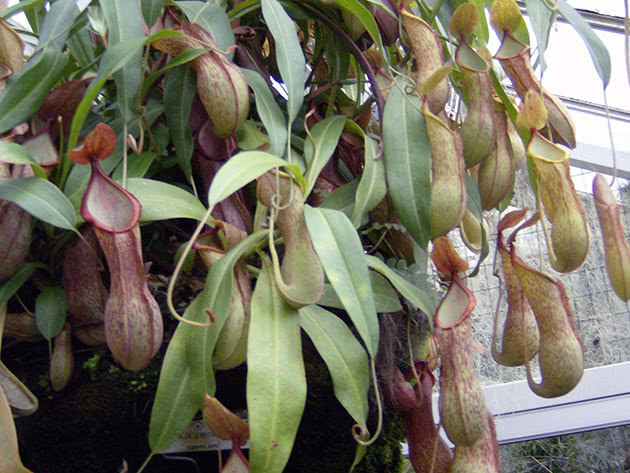

Nepenthes Rajah
The rarest and largest liana in the world grows up to 6 m in natural conditions. Its jugs reach 16 cm in width and 35 cm in length. This plant feeds not only on insects, but also on small vertebrates;


Nepenthes madagascariensis
Insectivorous perennial from 60 to 90 cm high with oblong-lanceolate leaves and winged crimson jugs up to 25 cm long;


Nepenthes rafflesiana
This is a Sumatran epiphyte with oval lanceolate leaves up to 50 cm long and about 10 cm wide.Light green jugs with red stripes and spots reach a length of 10 to 20, and a width of 7 to 10 cm.The inner cavity of the jug is painted in a bluish tint and covered with red spots;
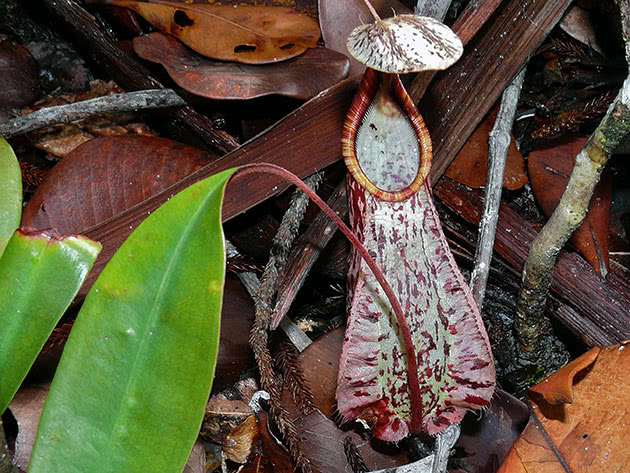

Nepenthes truncata
Endemic from the Philippine island of Mindanao, growing in the mountains at an altitude of 230 to 600 meters. Some of its varieties can be found in higher mountainous areas. Jugs of this type reach a length of 50 cm, so the plant is grown mainly in a greenhouse;
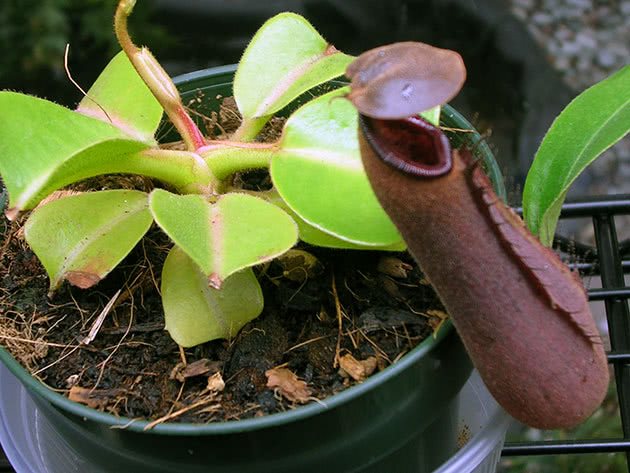

Nepenthes gracillima
In nature, it reaches a length of 5 m. It has long, but narrow leaves and green cylindrical jugs with red and dark green specks;
Nepenthes Miranda
It is a semi-epiphyte with large pungent green jugs with bright red specks;
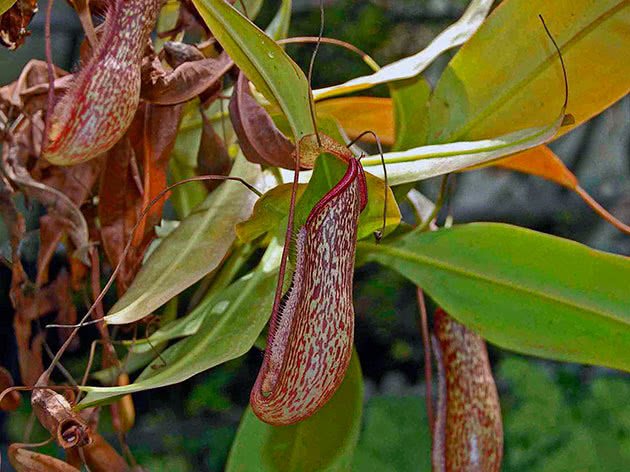

Nepenthes maxima
It grows in length only up to 3 m. It has long - up to 30 cm - narrow leaves. The upper cylindrical jugs grow in length up to 30 cm, the lower flask-shaped ones are much shorter. The color of the traps is yellow-green, their surface is covered with warty red projections;
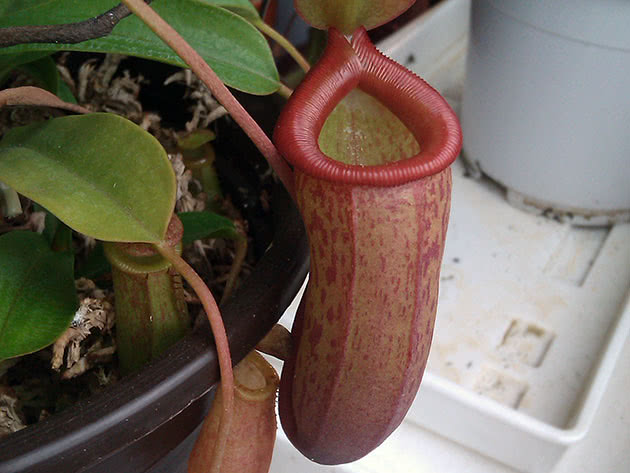

Nepenthes attenboroughii
It grows on the Philippine island of Palawan. It is a shrub up to 1.5 m high and branches up to 3.5 cm thick, with leathery, almost sessile leaves and jugs up to 1.5 liters in volume, about 25 cm long and about 12 cm wide. The color of the jugs is bright green with a purple streak;
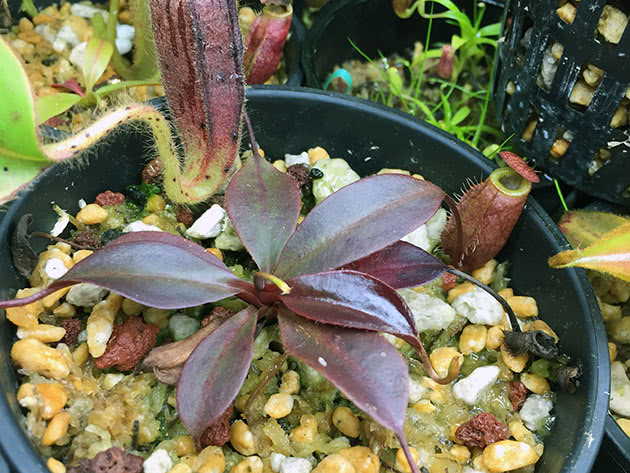

Where does nepentes raja grow?
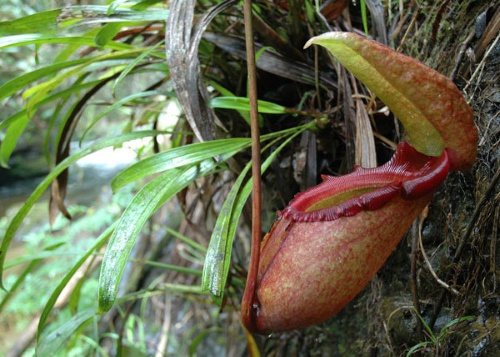

The climate of the humid jungle or highlands is perfect for the Nepenthes. Madagascar, the southeastern territories of Australia and Asia - this is where these predators grow. But nepentes raja can be found only on the island of Borneo, where it grows on Mount Kinabalu.The plant belongs to endangered species and is protected by international conventions.
Let's get to know better
Nepenthes is a plant of the genus belonging to the monotypic family Nepenthaceae. It has over 100 species of predatory plants and their natural hybrids. The name comes from the word "nepenthus", which in ancient Greek mythology meant "the herb of oblivion." People call Nepentes more simply - Pitcher or Mukholov.


Nepentes in the wild
In the wild, the pitcher grows in the forests of tropical Asia and on the islands of the Pacific basin. Most often, the flower is found on the island of Kalimantan, in the Seychelles and Madagascar, in New Caledonia and Northern Australia. Moreover, some species of these predatory plants lurked on the green plains, others - settled high in the mountains, and the third likes peat bogs and wetlands. Many species of Nepentes inhabit trees. With their long herbaceous stems, they climb branches and trunks to unprecedented heights in search of sunlight for their inflorescences. It happens that plants lose contact with the earth, not receiving any nutrients from their neighbors, that is, they are essentially epiphytes. It is here that they simply have to feed on insects in order to survive.
The plant has strong symbiotic bonds with some representatives of the animal world. For example, mountain tupai use Nepentes with large pitchers-traps as dry closets. They feast on the nectar of the plant and leave their droppings in the jugs, which the plant then digests and assimilates as nitrogen fertilizer. Bats often climb into large jugs to sleep, where they are not bothered by heat and insects. They also leave their excrement, which contains the nitrogen necessary for the plant, in the trap.
Types of homemade nepentes with photos and names
There are several popular types of nepentes in culture.
Winged nepentes Nepenthes alata


Leaves are dark green, elongated. Narrow large jugs are painted in pistachio color, "decorated" with red dots. Can withstand temperatures lowered to + 12 ° C, undemanding to air humidity.
Nepentes graceful (N. gracilis), nepentes Rafflesi (N. rafflesiana)


Long shoots are covered with elongated (up to 0.5 m) large leaves on low petioles. Small jugs: width - up to 0.1 m with a length of up to 0.2 m. Painted outside in light green with burgundy stripes; inside they are bluish.
Reproduction methods
You can propagate the nepentes flower with apical cuttings or seeds. Vegetative propagation is considered the most convenient. Cuttings with several leaves are cut from January to April. The cut is made slightly below the sheet so that a small leg remains. Pieces of sphagnum moss are placed in a small pot and a stalk is fixed in it with the help of a wire. The plant should be kept in a warm place (+ 25 ... + 30 ° C) and periodically sprayed with a spray bottle. Rooting takes 4-6 weeks. The grown nepentes is transplanted into a permanent pot.
Liana-like varieties can be propagated by air layers. To do this, part of the bark of the flexible shoot is removed and the vine is pressed to the ground. After a few weeks, the roots appear and the layers can be separated from the mother plant.
Seed propagation should be carried out immediately after harvest. They are sown in small boxes with a mixture of sphagnum moss and sand. The container is kept in a humid and warm place (+ 22 ... + 25 ° C). Seedlings appear in 1.5-2 months.
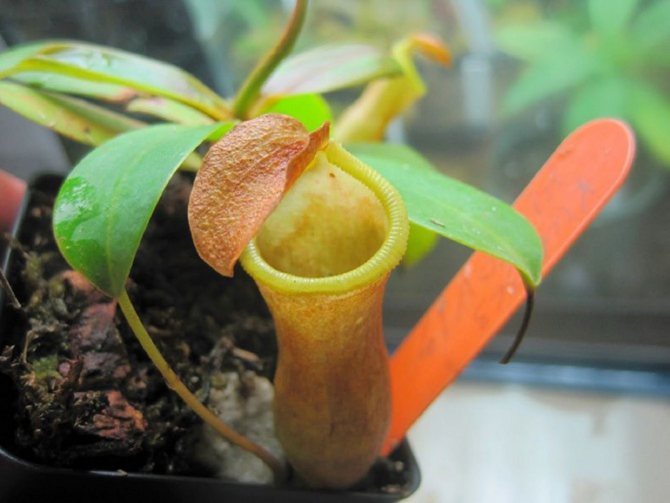

General information
Nepentes are carnivorous plants. Insects serve as food for them. In the wild, they grow mainly in peat bogs in acidic soil. There are very few nutrients for the roots of plants to absorb. But nepentes survive in these conditions too. And they adapted thanks to their unusual leaves, which resemble a jug in shape.The jug has a special lid for catching various insects: flies, mosquitoes, beetles ... The leaves are quite large. From the lid of a jug-leaf that produces nectar, insects fall down to its bottom. They cannot hold, since the inner surface, that is, the walls of the sheet, is covered with wax. Once trapped, the insect begins to rush about, which causes the activity of the glands inside the jug. These glands produce caustic substances that are fully capable of digesting a fly in a couple of days.
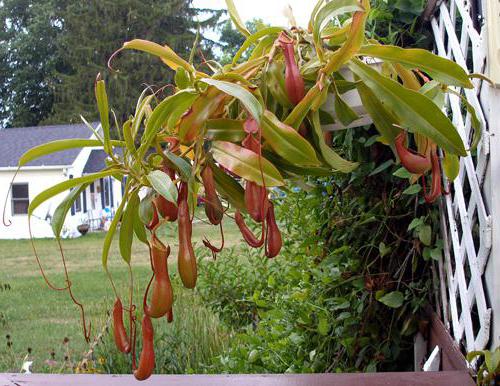

Nepentes - interesting facts
An unusual predatory plant a few years ago could only be seen in nature or in parks. Several interesting facts are known about him:
- The name nepentes comes from ancient mythology, where the herb of oblivion was called so.
- Another name is "hunting cups", and this is due to the fact that the liquid in the water lilies can be drunk, but only the upper level. From each jug, you can get about a sip of clean water.
- Liana often parasitizes trees in order to climb higher to the sun
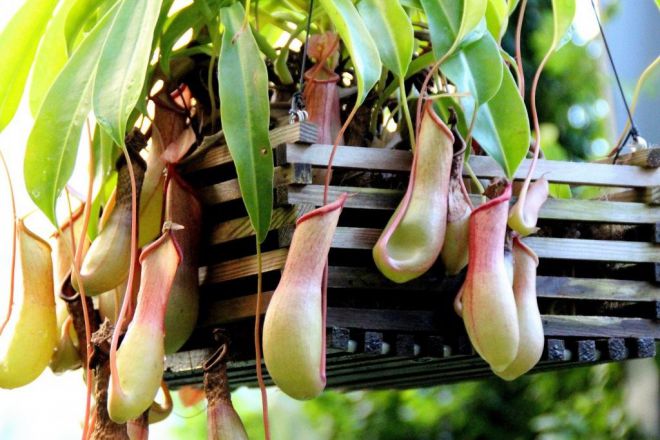

General description with photo
Nepentes from the family of Nepenthos is a representative of mixotrophs - plants with a special type of nutrition, able to receive what they need for life from different sources, depending on the circumstances. This way of nutrition has been formed over the centuries and is due to the harsh conditions of natural growth. The inflorescence of nepentes is a closing vessel that also increases in size as it grows and develops. Inside the flower, nectar is produced, the aroma of which attracts insects. However, having fallen into a trap, they can no longer get out. Dead insects or rodents dissolve under the influence of this nectar, and the plant takes from these remains everything necessary for its development.
However, calling the pitcher traps flowers is not entirely correct, in fact, these are modified leaves. They can look very different in shape, color and size, depending on the varieties.
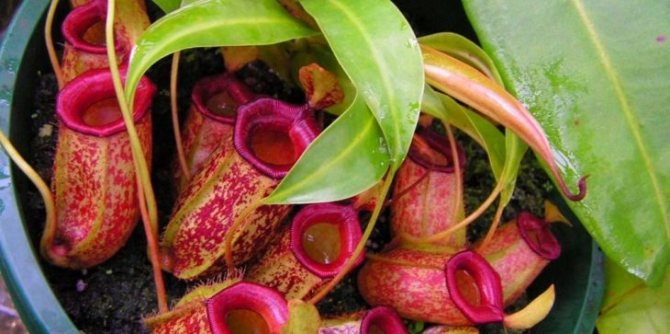

Reproduction
You can expand the plantation of your favorite nepentes crops in several ways - by cuttings, aerial shoots, seeds, dividing the bush.
Seeds
This is a long process that requires patience from a person: seeds can germinate for 2 months, and only if they were fresh. For planting, a mixture of coarse clean sand and sphagnum is prepared; it must be periodically moistened.
Cuttings
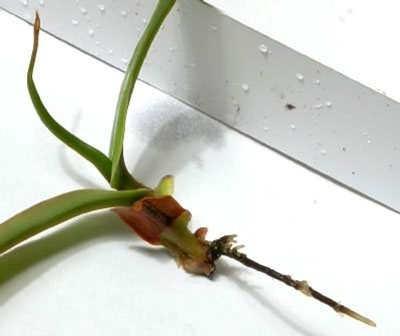

This method is used most often. To achieve the desired result, you need:
- harvest cuttings in the spring;
- use a knife with a sharp blade;
- make sure that there are 3 leaves on the cut shoot, no less, otherwise the cutting will not take root;
- before planting, treat the cuttings with foundation or other disinfectant.
If all the conditions are met, after a month and a half, the root system will form in the cuttings. All this time, touching it is prohibited - there is a danger of damaging the delicate roots.
By dividing the bush
Only an experienced florist usually decides on such a procedure. The bush can be divided during the transplantation process (this is usually done with other crops), but in this case you have to deal with very fragile roots, there is a risk of ruining the entire plant.
How to propagate nepentes?
The most common method of propagation is by cutting off cuttings or using nepentes seeds. Cuttings are placed for a short time up to 1 hour in a growth stimulant solution, then rooted in light soil or sphagnum moss.
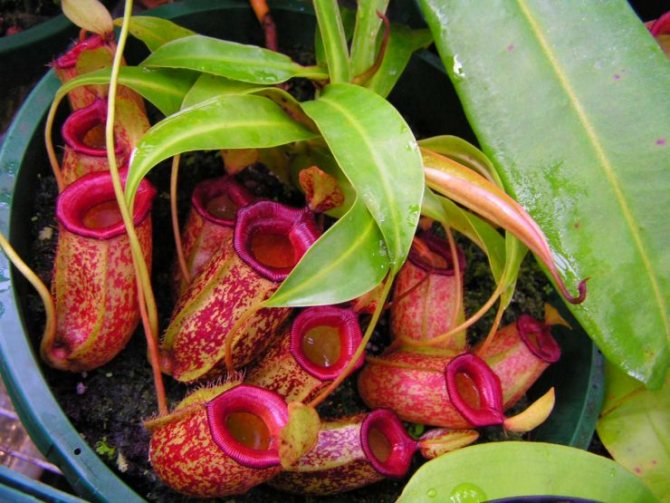

In order for the flower to take root, it is necessary to observe the temperature regime, maintain air humidity. You need to be especially careful about the presence of a large amount of light.
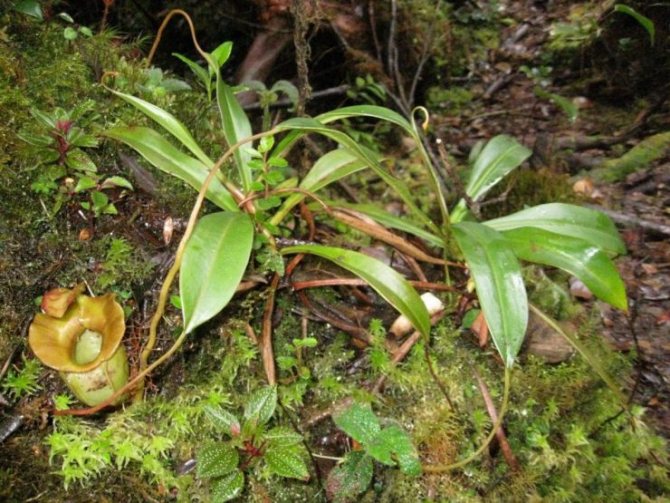

Growing in a pot culture
Nepentes Winged is most commonly found as a houseplant.
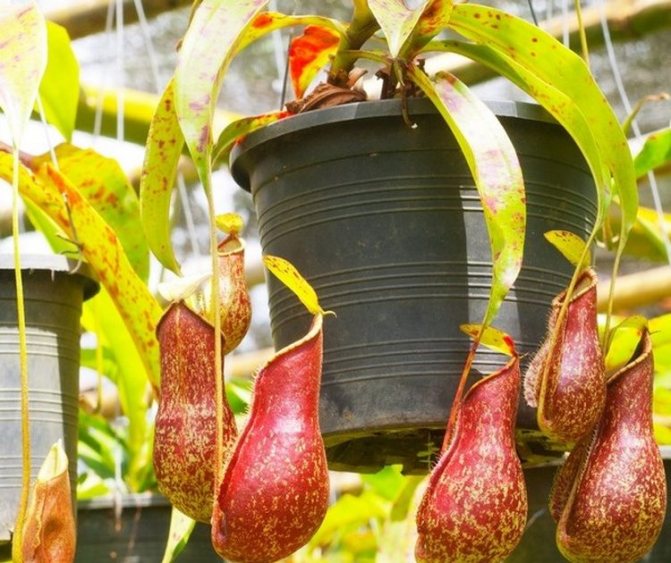

Nepentes Winged
Nepentes Rafflesi is an epiphyte with a large spotted trapping leaf, a "jug" of purple color.
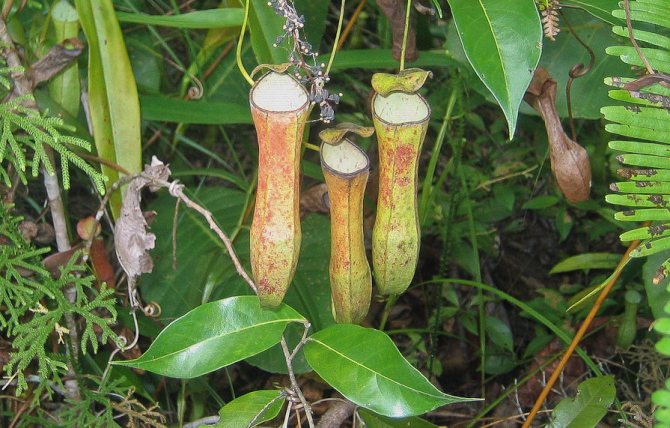

Nepentes Rafflesi in vivo
Nepentes the Truncated has a very large pitcher.
Nepentes Hairy has a "jug" about 20 cm long and 5-12 in diameter. Its rim is very fleshy and colored red.
History
The first mention of Nepentes dates back to 1658, when the French governor Etienne de Flacorte traveled around Madagascar. He was amazed by the unusual appearance of the plant. The second description refers to the year 1680. It was compiled by the German traveler and adventurer Jacob Brain. But they all saw in front of them only a beautiful plant and did not know that it was catching insects.
Natural scientist Karl Linnaeus took up a serious study of the unique culture. He introduced the generic name "Nepenthes" into scientific circulation in 1753 in his work Species Plantarum. Linnaeus named it after the legendary herb of oblivion, nepenth, mentioned in Homer's Odyssey. According to the myth, the Spartan princess, the beautiful Helena, received the nepenthus herb from the queen of Egypt. She invited her son Odysseus Telemachus to forget all the sorrows and sorrows. The word nepenthes itself is translated from Latin as "no sadness." Nepentes was sometimes used in place of opium. This plant is mentioned, by the way, in the poems of the famous American writer Allan Edgar Poe, who, according to the testimony of his contemporaries, often resorted to drugs.
In the 19th century, nepentes gained real popularity. Its species and hybrids were grown in his famous nursery by the scientist botanist Peter Christian. Since the 1960s, these plants have boomed again thanks to the work of the Japanese botanist Shigeo Kurata.
Today, more than a hundred species and several hundred hybrids of nepentes are known, some of which are sold in flower shops.


Nepentes: photo
And here is another photo of various types of nepentes:
The video tells in detail about the different varieties of nepentes growing in the jungle:
Application
The Nepentes were used in a variety of ways. Their liquid can serve as a pleasant drink, and the shoot can even be used as a building material, and the inhabitants of the tropics cooked rice in its jugs.
In folk medicine, juice is used as a remedy for cough and inflammation of the bladder, eye disease and skin inflammation. Decoctions from the roots and stems are drunk with dysentery or malaria.
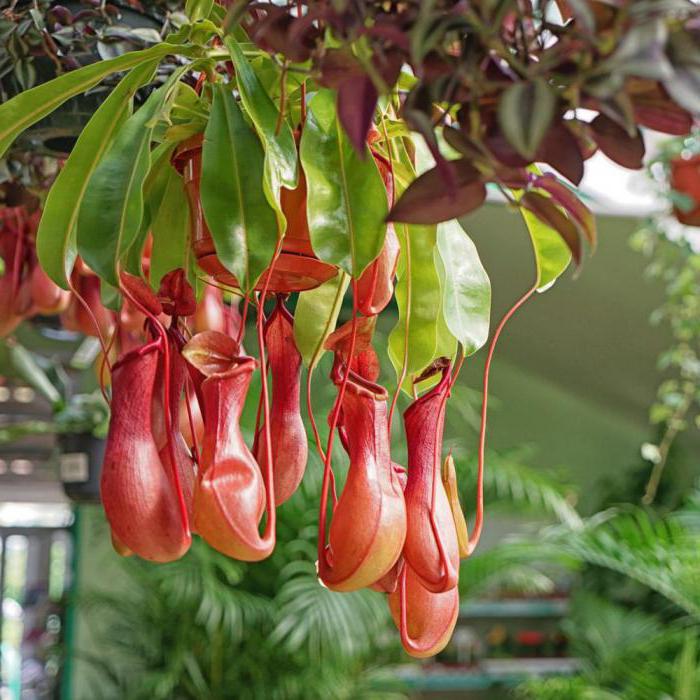

Lighting and temperature
Nepentes needs a well-lit place, but protected from direct sunlight. Direct sunlight can burn their delicate leaves. The flower does not like changes in place, this can lead to a developmental disruption. Due to insufficient light in winter, traps may stop growing, and existing ones may dry out. However, with the arrival of spring, the situation should return to normal. Nepentes needs a fairly high temperature, which should be at room temperature practically all year round. In winter and at night it can drop slightly to about 18-20 ° C (mountain species need even lower temperatures, especially at night), but during the growing season the temperature should be quite high and be in the range of 22-35 ° C.
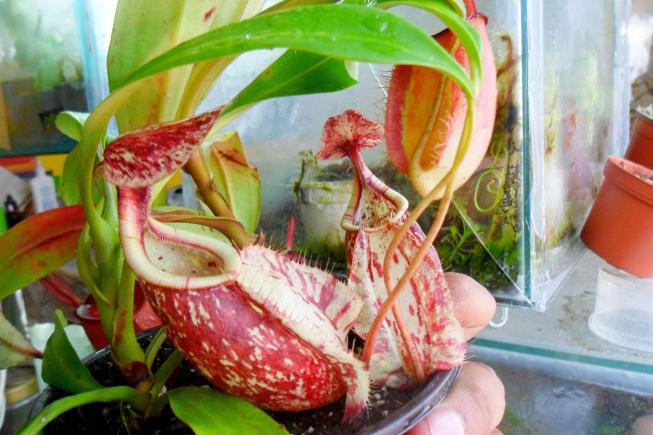

Food
A good choice would be Nepentes, whose organs for capturing insects are highly visible and much more visible than, for example, sundews. They also have a very interesting shape, reminiscent of a jug with a smooth edge (covered with a slippery substance, insect bait) and a lid that prevents rainwater from entering. Inside such a trap, at the very bottom, there is a liquid for digesting victims (for example, in the form of a fly). The insect, lured by the color and special aroma, immediately gets inside the trap and has no chance to get out of it. Slippery walls, curved downwards, reminiscent of the shape of a decanter, effectively retain the captured insect. Of course, nepentes does not rely only on this way of feeding, since it also has green leaves, which are used for the production of food in the process of photosynthesis, and in case of a shortage of food of organic origin, it feeds in the classical way like ordinary plants.
